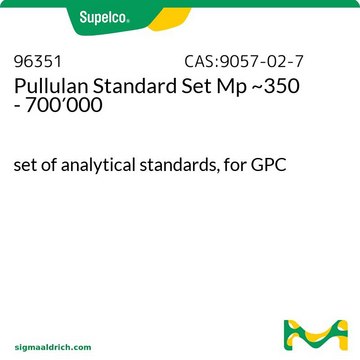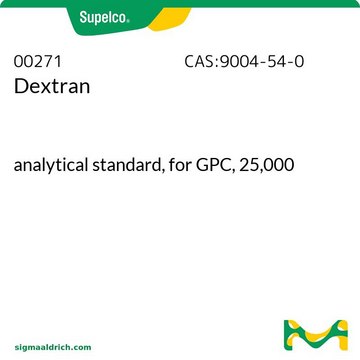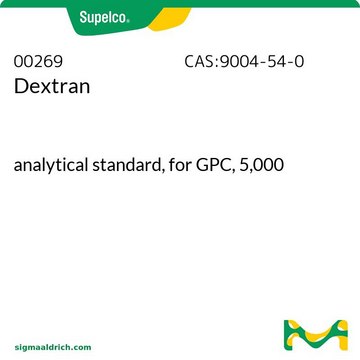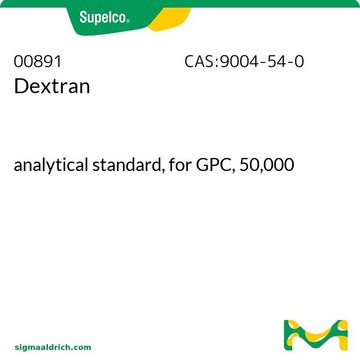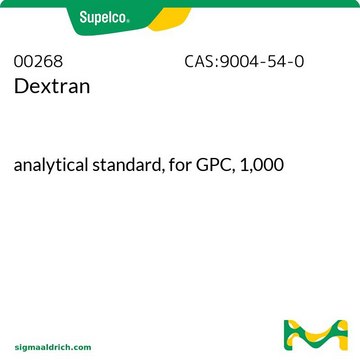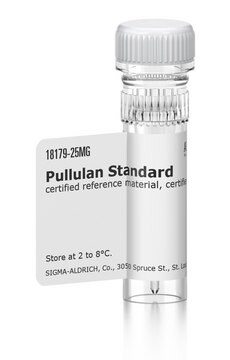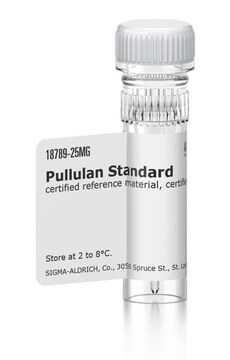31430
Dextran
analytical standard, for GPC, Set Mp 1,000-400,000
Sign Into View Organizational & Contract Pricing
All Photos(1)
About This Item
Linear Formula:
[C6H10O5]n
CAS Number:
EC Number:
MDL number:
UNSPSC Code:
41116107
NACRES:
NA.24
Recommended Products
grade
analytical standard
for GPC
Quality Level
mol wt
Mp 1,000-400,000
analyte chemical class(es)
oligosaccharides
technique(s)
gel permeation chromatography (GPC): suitable
application(s)
food and beverages
format
neat
InChI
1S/C18H32O16/c19-1-5(21)9(23)10(24)6(22)3-31-17-16(30)14(28)12(26)8(34-17)4-32-18-15(29)13(27)11(25)7(2-20)33-18/h1,5-18,20-30H,2-4H2
InChI key
FZWBNHMXJMCXLU-UHFFFAOYSA-N
Looking for similar products? Visit Product Comparison Guide
General description
Dextran is an exopolysaccharide synthesized by lactic acid bacteria from sucrose. It consists of repeating units of D-glucose with the monomers joined to each other through α-1,6 linkages. In addition, the linear D-glucose chains show branching at frequent intervals, linked by α-1,4, α-1,3, or α-1,2 linkages.
Application
The analytical standards can also be used as follows:
- High-performance size exclusion chromatography (HPSEC) based determination of the molecular weight of a dextran synthesized by Leuconostoc citreum B-2, isolated from a fermentation product of pineapple
- Determination of molecular weight of polysaccharides obtained from four Auricularia species by high-performance liquid chromatography using a water-soluble gel column
- Identification of molecular weight of a water-soluble polysaccharide isolated by anion exchange chromatography from the dried leaves of C. paliurus by gel permeation chromatography (GPC)
- Gel permeation chromatography (GPC) based molecular weight measurement of a dextran produced by two strains of Leuconostoc mesenteroides
- Estimation of molecular weight of a water-soluble polysaccharide obtained from thinned-young apple by high-performance size exclusion chromatography (HPSEC)
Components
set contains 10 different dextran standards with 500 mg with Mp ~1,100 (Cat. No. 31416), ~4,400 (Cat. No. 31417), ~10,000 (Cat. No. 31418), ~20,000 (Cat. No. 31419), ~45,000 (Cat. No. 31420),~65,000 (Cat. No. 31421), ~125,000 (Cat. No. 31422), ~195,000 (Cat. No. 31423), ~275,000 (Cat. No. 31424), ~400,000 (Cat. No. 31425); The components can also be ordered separately under the product numbers indicated.
Storage Class Code
11 - Combustible Solids
WGK
WGK 2
Personal Protective Equipment
dust mask type N95 (US), Eyeshields, Gloves
Choose from one of the most recent versions:
Already Own This Product?
Find documentation for the products that you have recently purchased in the Document Library.
Customers Also Viewed
Erik C B Johnson et al.
Molecular neurodegeneration, 15(1), 53-53 (2020-09-15)
Alzheimer's disease (AD) is the most frequent and costly neurodegenerative disorder. Although diverse lines of evidence suggest that the amyloid precursor protein (APP) is involved in its causation, the precise mechanisms remain unknown and no treatments are available to prevent
Amy Huei-Yi Lee et al.
PLoS pathogens, 8(2), e1002523-e1002523 (2012-02-10)
The eukaryotic cytoskeleton is essential for structural support and intracellular transport, and is therefore a common target of animal pathogens. However, no phytopathogenic effector has yet been demonstrated to specifically target the plant cytoskeleton. Here we show that the Pseudomonas
Chad G Pearson et al.
The Journal of cell biology, 187(6), 905-920 (2009-12-17)
Centrioles are the foundation for centrosome and cilia formation. The biogenesis of centrioles is initiated by an assembly mechanism that first synthesizes the ninefold symmetrical cartwheel and subsequently leads to a stable cylindrical microtubule scaffold that is capable of withstanding
Non-adsorbing macromolecules promote endothelial adhesion of erythrocytes with reduced sialic acids.
Yang Yang et al.
Biochimica et biophysica acta, 1840(1), 288-293 (2013-10-01)
Abnormal adhesion of red blood cells (RBCs) to vascular endothelium is often associated with reduced levels of sialic acids on RBC membranes and with elevated levels of pro-adhesive plasma proteins. However, the synergistic effects of these two factors on the
Elizabeth M Bradshaw et al.
Nature neuroscience, 16(7), 848-850 (2013-05-28)
In our functional dissection of the CD33 Alzheimer's disease susceptibility locus, we found that the rs3865444(C) risk allele was associated with greater cell surface expression of CD33 in the monocytes (t50 = 10.06, P(joint) = 1.3 × 10(-13)) of young
Our team of scientists has experience in all areas of research including Life Science, Material Science, Chemical Synthesis, Chromatography, Analytical and many others.
Contact Technical Service